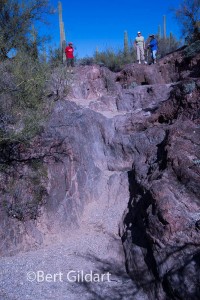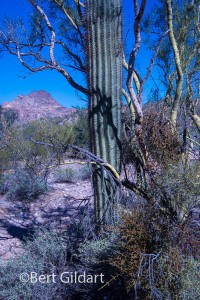Allocating Water in Organ Pipe NM
©Bert Gildart: In the Sonoran desert, characterized in part by Organ Pipe Cactus National Monument, everything seems to revolve around water, and generally, from the scarcity of it.
For the past few days as we’ve been hiking and biking the area, that fact has been driven home. Several days ago, we hiked to Red Tanks Tinaja, a formation that is configured to collect water, something it apparently does well, for the damp sands were stippled with the tracks of ungulates, perhaps peccaries or the endangered Sonoran antelope.
But more prominently it was impossible to escape the struggling beauty of saguaros embraced as they were by the limbs of the verdant palo verde. At the trailhead to the Red Tanks Tinaja, Park Service interpretive panels explained that saguaros have been here for almost 10,000 years. To survive, the panel explains that the seeds creating these trees thrive only when they chance to fall in the presence of a nurse plant such as the palo verde. In their embrace saguaros generally survive, for the thick-leaved plant can offer much-needed shade and sometimes, too, shelter from harsh rains. As well, the palo verde can hide its then-tiny charge from being seen and then eaten.”
Compassionate Water Tanks, to assist struggling life In Organ Pipe
Lastly, it has been impossible to forget my chance sighting last year of four compassionate water tanks located while biking one of the park’s more remote areas. As I’ve learned from reading the absolutely incredible book entitled The Devil’s Highway, many undocumented immigrants have perished while trying to steal through this park – hoping to find a better life in the States.
The tanks are still there, but this year it appeared as though they were seldom used. Nevertheless, in combination with the more natural features just described, they are all reminders that heat is a killer, resolved in part by the presence of water.
Red Tanks Tinaja helps collect water; palo verde shelters organ pipe seeds that have chanced to fall in its area of purview
Lesson? Carry lots when you explore, particularly now as the Sonoran winter gives way to an unexpectedly warm spring. Today, on this February the 13th, here at noon, it is according to our Airstream thermometer 97ºF – outside.
We have no hookups.
———————
4th ed. Autographed by the Authors
Hiking Shenandoah National Park
 Hiking Shenandoah National Park is the 4th edition of a favorite guide book, created by Bert & Janie, a professional husband-wife journalism team. Lots of updates including more waterfall trails, updated descriptions of confusing trail junctions, and new color photographs. New text describes more of the park’s compelling natural history. Often the descriptions are personal as the Gildarts have hiked virtually every single park trail, sometimes repeatedly.
Hiking Shenandoah National Park is the 4th edition of a favorite guide book, created by Bert & Janie, a professional husband-wife journalism team. Lots of updates including more waterfall trails, updated descriptions of confusing trail junctions, and new color photographs. New text describes more of the park’s compelling natural history. Often the descriptions are personal as the Gildarts have hiked virtually every single park trail, sometimes repeatedly.
Big Sky Country is beautiful
Montana Icons: 50 Classic Symbols of the Treasure State
![]() Montana Icons is a book for lovers of the western vista. Features photographs of fifty famous landmarks from what many call the “Last Best Place.” The book will make you feel homesick for Montana even if you already live here. Bert Gildart’s varied careers in Montana (Bus driver on an Indian reservation, a teacher, backcountry ranger, as well as a newspaper reporter, and photographer) have given him a special view of Montana, which he shares in this book. Share the view; click here.
Montana Icons is a book for lovers of the western vista. Features photographs of fifty famous landmarks from what many call the “Last Best Place.” The book will make you feel homesick for Montana even if you already live here. Bert Gildart’s varied careers in Montana (Bus driver on an Indian reservation, a teacher, backcountry ranger, as well as a newspaper reporter, and photographer) have given him a special view of Montana, which he shares in this book. Share the view; click here.
$16.95 + Autographed Copy
What makes Glacier, Glacier?
Glacier Icons: 50 Classic Views of the Crown of the Continent
![]() Glacier Icons: What makes Glacier Park so special? In this book you can discover the story behind fifty of this park’s most amazing features. With this entertaining collection of photos, anecdotes and little known facts, Bert Gildart will be your backcountry guide. A former Glacier backcountry ranger turned writer/photographer, his hundreds of stories and images have appeared in literally dozens of periodicals including Time/Life, Smithsonian, and Field & Stream. Take a look at Glacier Icons
Glacier Icons: What makes Glacier Park so special? In this book you can discover the story behind fifty of this park’s most amazing features. With this entertaining collection of photos, anecdotes and little known facts, Bert Gildart will be your backcountry guide. A former Glacier backcountry ranger turned writer/photographer, his hundreds of stories and images have appeared in literally dozens of periodicals including Time/Life, Smithsonian, and Field & Stream. Take a look at Glacier Icons
$16.95 + Autographed Copy




